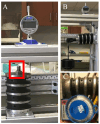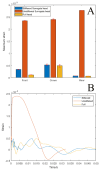Anatomical Features and Material Properties of Human Surrogate Head Models Affect Spatial and Temporal Brain Motion under Blunt Impact
- PMID: 39061732
- PMCID: PMC11273380
- DOI: 10.3390/bioengineering11070650
Anatomical Features and Material Properties of Human Surrogate Head Models Affect Spatial and Temporal Brain Motion under Blunt Impact
Abstract
Traumatic brain injury (TBI) is a biomechanical problem where the initiating event is dynamic loading (blunt, inertial, blast) to the head. To understand the relationship between the mechanical parameters of the injury and the deformation patterns in the brain, we have previously developed a surrogate head (SH) model capable of measuring spatial and temporal deformation in a surrogate brain under blunt impact. The objective of this work was to examine how material properties and anatomical features affect the motion of the brain and the development of injurious deformations. The SH head model was modified to study six variables independently under blunt impact: surrogate brain stiffness, surrogate skull stiffness, inclusion of cerebrospinal fluid (CSF), head/skull size, inclusion of vasculature, and neck stiffness. Each experimental SH was either crown or frontally impacted at 1.3 m/s (3 mph) using a drop tower system. Surrogate brain material, the Hybrid III neck stiffness, and skull stiffness were measured and compared to published properties. Results show that the most significant variables affecting changes in brain deformation are skull stiffness, inclusion of CSF and surrogate brain stiffness. Interestingly, neck stiffness and SH size significantly affected the strain rate only suggesting these parameters are less important in blunt trauma. While the inclusion of vasculature locally created strain concentrations at the interface of the artery and brain, overall deformation was reduced.
Keywords: TBI; brain motion; human head surrogate; injury thresholds.
Conflict of interest statement
The authors declare no conflict of interest.
Figures










References
-
- Surveillance Report of Traumatic Brain Injury-Related Emergency Department Visits, Hospitalizations, and Deaths. The National Center for Injury Prevention and Control (NCIPC), Centers for Disease Control and Prevention (CDC), U.S. Department of Health and Human Services; Atlanta, Georgia: 2014.
-
- Coronado V.G., Xu L., Basavaraju S.V., McGuire L.C., Wald M.M., Faul M.D., Guzman B.R., Hemphill J.D., Centers for Disease Control and Prevention (CDC) Surveillance for traumatic brain injury-related deaths--United States, 1997–2007. MMWR Surveill. Summ. 2011;60:1–32. - PubMed
Grants and funding
LinkOut - more resources
Full Text Sources
Medical
Research Materials

